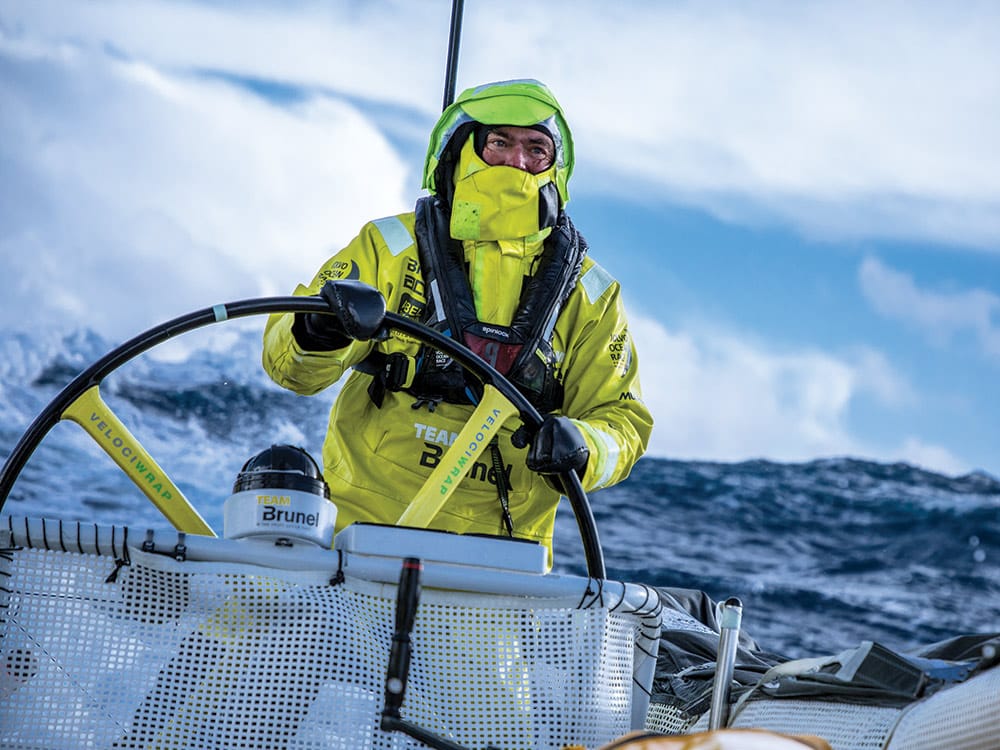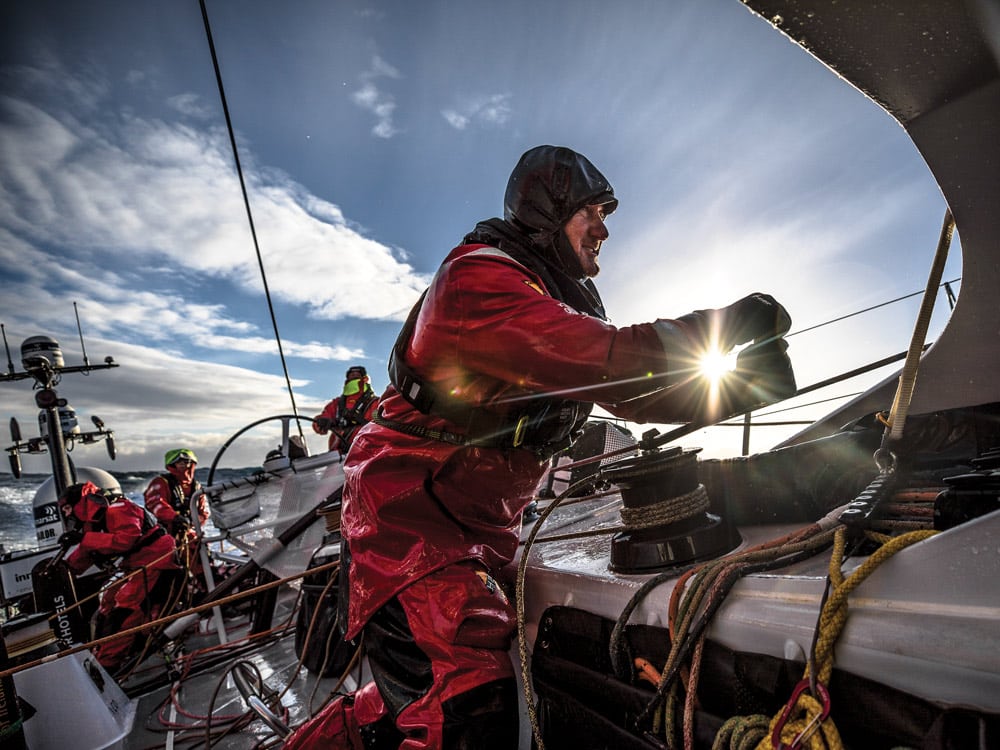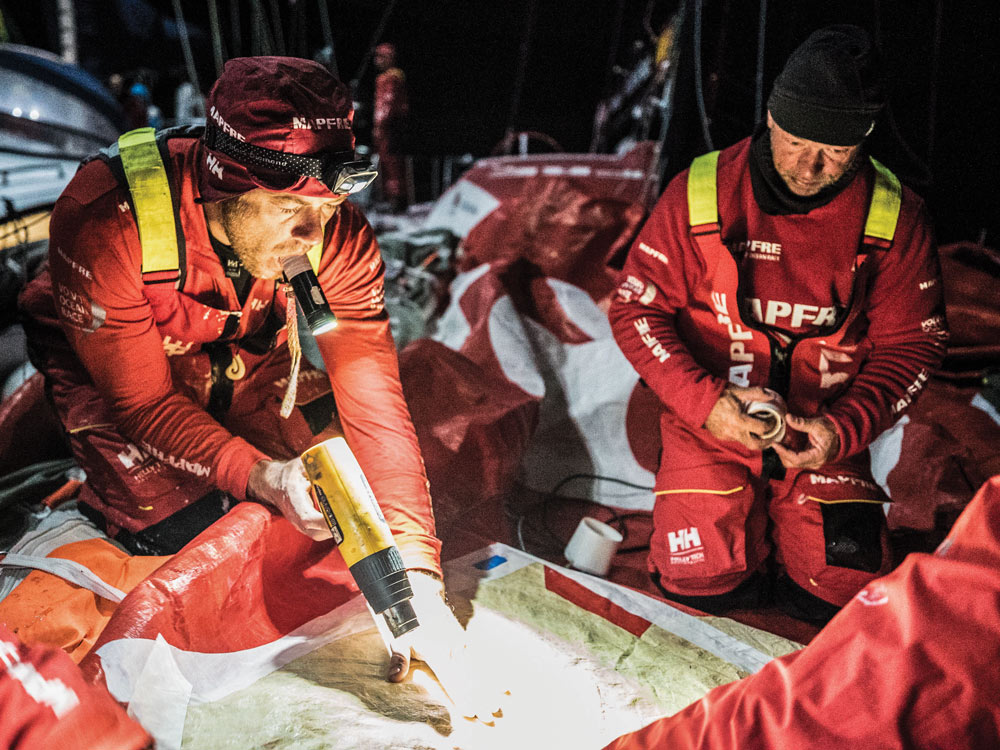
Leg 7 from Auckland to Itajai, day 10 on board Brunel. Bouwe Bekking driving in a big sea state. 27 March, 2018.
On paper, the second Southern Ocean leg of the Volvo Ocean Race is 7,600 miles, the longest of the race by a lot. These are the difficult miles that push men, women and equipment to their breaking point. This classic and defining segment of the race can be fast and kind, but more often than not, it’s fast and brutal, the sort of leg that finds even the most hardened veterans and masochists clamoring for the exit door at Cape Horn. Such will be remembered of the 2018 edition, the one that claimed one life and stripped years off many others.
“The Southern Ocean has been especially tough this year,” wrote Simon Fisher, navigator and helmsman for Vestas 11th Hour Racing, hours before they passed the iconic landmark in the wake of Team Brunel on March 29, 10 days after leaving Auckland, New Zealand. “It has been more relentless and unforgiving than I can ever remember.”
Weighing on Fisher’s mind and casting a somber pall across the fleet was the unsettling death of Sun Hung Kai/Scallywag’s 48-year-old crewmember John Fisher, knocked overboard during an accidental jibe and declared lost at sea after an impossible search.
“In the past week, it feels as if we have been battered by storm after storm. And yet another squall is never far away,” said Simon Fisher. “As the clouds that bring the squalls roll by, we are hit by 35- to 40-knot gusts, not to mention a mixture of hail and snow. The novelty of making snowballs has long since worn off. This is sailing at its most extreme.”
The bitter cold, relentless speed from running with consecutive storms and lack of sleep following countless jibes against the race-imposed ice-exclusion zone had worn down everyone, added Fisher. Videos and photos transmitted from every boat, including Vestas, revealed the sunken eyes, blistered and frostbiting hands, wind-burned cheeks and the lethargic and calculated movements of the sailors.
“As we brace ourselves for the final few days of strong winds, Cape Horn cannot come soon enough,” closed Fisher. “We have endured many days of heavy weather, storms, squalls, snow, hail and freezing temperatures. Massive waves and howling winds, and all this in a fleet so close and so competitive that we are given no choice but to push to the limit 100 percent of the time. Rounding Cape Horn this time will be more satisfying than ever.”
As monumental as the rounding is for those who’ve done it, including Team Brunel’s Bouwe Bekking — his ninth — there was barely a moment for slaps on the back, a cigar and a nip of rum, for there were still 2,000 miles to go before the finish in Itajai, Brazil.
“The crew is very, very, very tired,” wrote Bekking. “Even though we are leading, there is no ‘hurray’ feeling on board. The loss of John is sitting way deeper than people like to admit. I think of him several times in an hour. It didn’t come easy this leg. As everybody knows, it was a windy one.”

Leg 7 from Auckland to Itajai, day 9 on board Sun Hung Kai/Scallywag. John Fisher winding the winch during a sail change. 26 March, 2018.
Only partway through the leg did the teams get a 24-hour respite from the hard racing and close battle being waged in the position reports. Crews seized the opportunity to mend and prepare their bodies and boats for one last punishing low that would propel them toward Cape Horn. Once the wind got cranking again, they were right back into it.
“We had some 40 to 45 knots, which is no fun. Actually, it is pure survival mode,” wrote Bekking on March 25, four days out from the Horn. “But still doing between 22 and top speeds of 39 knots, crazy. But you know the others don’t hold back either. Backing down now? No way. Anybody will do this. It is the way we sail.”
A day earlier, navigator Libby Greenhalgh confessed to “some trying times” on board Scallywag as they jibed against the ice gate. The Hong Kong/Australian entry was seemingly falling farther behind the fleet with every maneuver. Crash jibes weren’t helping their cause. “The motivation to push ourselves has to come from within the team, especially when you are short jibing and cannot immediately display the benefit from the boats around,” wrote Greenhalgh. “There is no one there, just us, and that middle of the ocean suddenly seems very far and very alone.”
Two days later, with the Southern Ocean in full noise, her words rang true. Fifteen minutes before sunrise, in 35 to 45 knots of wind and 15-foot boiling seas, the 65-footer reportedly surfed down a wave and then spun into an accidental jibe.
According to a team statement, John Fisher was transiting the cockpit, moving forward to tend to a headsail sheet when “the mainsheet system caught John and knocked him off the boat.” Because of his movement at the time, he was not tethered.

Leg 7 from Auckland to Itajai, day 12 on board MAPFRE, Antonio Cuervas-Mons warming up the glue, 30 March, 2018.
A Jonbuoy and horseshoe were deployed, but by the time the team had stowed headsails and motorsailed back to the MOB location, they were unable to find buoys nor Fisher. With a powerful storm barreling down on them and the British sailor’s chances of survival diminished, the searching ended and the mourning began.
As Scallywag rerouted to Chile, its competitors soldiered on toward Cape Horn with yet another low-pressure punch, with more crash jibes and broken bits and bones to write home about.
It was then Mapfre‘s turn, when the overall race leader revealed it’d been dealing with a compromised mainsail track, which was giving the team dire concerns. They’d effected a jury rig, and knowing the next failure was a dismasting, they dispatched a small shore team to the remote South American tip. Skipper Xabi Fernandez hadn’t anticipated their mainsail parting from luff to leech while en route, so Mapfre‘s anticipated pit stop before rounding the Horn proved to be a wise choice after all. Thirteen hours after suspending racing, with a bandaged mainsail, a reglued track and a critical repair to the boom performed, they were back on the racetrack, in slow pursuit of the front-runners. They too were happy to leave the Southern Ocean, with all its splendor and misery.
Proving, however, that one is never done until the docklines are secured, word came on March 30 that Vestas 11th Hour Racing, second around the Horn, dismasted approximately 100 miles southeast of the Falkland Islands. The crew was forced to cut away the broken mast to avoid damage to the hull and motored under its own power toward the islands. At press time, the team was motoring to Itajai, this time putting a few thousand hard miles on its Volvo Penta saildrive.









